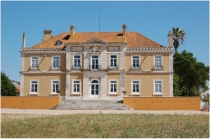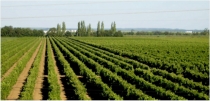Tejo
Wine region: TEJO
The history of viticulture in the Tejo includes proof of Phoenician and Roman presence in the region. Charters from the kings of the Alfonsine dynasty document its existence since the Reconquista. By the end of the first half of the 13th century, some 30,000 pipes of wine had been exported to England. In modern times, the populations of municipalities most involved with vine cultivation and wine production (Almeirim, Alpiarça, Cartaxo, Chamusca, Coruche, Rio Maior, Salvaterra de Magos and Santarém) has increased drastically because of viticulture. The VQPRD regions were established in 1989. Situated in the centre of Portugal, with a vast area of land utilised for agricultural purposes, this vitivinicultural region was created when it separated from the region formerly known as Ribatejo‑Oeste (Estremadura). The renaming of the Comissão Vitivinícola da Região Tejo (“Vitivinicultural Commission of the Tejo Region”) and changes to its policy occurred in 2008. Currently, the following 6 subregions are classified as DO: ALMEIRIM, CARTAXO, CHAMUSCA, CORUCHE, SANTARÉM and TOMAR.
The climate can be described as temperate southern Mediterranean, with an annual rainfall of 500–600 mm confined to the winter and spring months. The summer has high temperatures during the day, with moderate and hot temperatures at night. Negative temperatures are recorded in winter. The chief orographic accident is the Serra de Aires e Candeeiros mountain range, delimited by what we could call the Middle Tagus (Tejo) and the Tagus marshlands. The region has three distinct production zones: The “CAMPO”, “BAIRRO” and “CHARNECA”. Highly productive agricultural soils used for intensive farming, including that of viticulture, are found in the alluvial soils (CAMPO) on the extensive plains adjacent to the Tagus River (Rio Tejo), which are also known as the Tagus marshlands. BAIRRO, situated between the Tagus Valley and the foothills of the Porto de Mós, Candeeiros and Montejunto massifs has clay‑limestone soils on gently undulating terrain. CHARNECA lies to the south of CAMPO on the left bank of the Tagus River. With moderately fertile, sandy soils, its yields are lower than the regional average.
Currently the Tejo region has approximately 19,000 hectares planted to vineyards, of predominantly white grapevine varieties. Together with the red grapevine varieties, this region accounts for 10% of national wine production. The proportion of wines produced bearing the Designation of Controlled Origin (DOC) or regional wine certification has been growing steadily, and roughly 30% of these wines are earmarked for export.
The Comissão Vitivinícola Regional do Tejo (“The Tejo Regional Vitivinicultural Commission”) was officially approved as the certification authority mandated to regulate the production, trade and certification of vitivinicultural products entitled to bear the “DoTejo” Designation of Origin (DO) and the geographical indication, “Tejo” IG.
(Quotations primarily from IVV Yearbook)
Types of vitivinicultural products
Tejo IG wines or Tejo regional wines: Red, white, rosé, semi‑sparkling, light wine.
DoTejo Do wines (VQPRD) (the designations of the following subregions may be used: Almeirim, Cartaxo, Chamusca, Coruche, Santarém, Tomar): Red, rosé, white.
DoTejo DO sparkling wines (VEQPRD)
DoTejo DO liqueur wines (VLQPRD)
Aguardente de Vinho (brandy from wine spirit)
Vinagre de Vinho (wine vinegar)
Regional Contacts
Technical information: COMISSÃO VITIVINÍCOLA REGIONAL DO TEJO (“Tejo Regional Vitivinicultural Commission”) S. Pedro – Apartado 393, 2001‑905 SANTARÉM – Tel.: 243 309 400, Fax: 243 309 409
Cultural information on the wine of the region: Colegiada dos Enofílos de S. Vicente (“Collegiate of Oenophilists of São Vicente”), Av. Almirante Reis, 58 – r/c Dtº. Museu Rural e do Vinho do Concelho de Cartaxo (“Cartaxo Municipality Rural Museum and Wine Museum”), Avenida 25 de Abril, – Quinta das Pratas, 2070 000 Cartaxo; Website www.cm‑cartaxo.pt
Institutions of higher learning and viticultural research: Escola Superior Agrária de Santarém (ESAS) (Santarém Agricultural College), Quinta do Galinheiro – S. Pedro – Apartado 310, 2001‑904 Santarém; www.esa.ipsantarem.pt
Certification authority: COMISSÃO VITIVINÍCOLA REGIONAL DO TEJO S. Pedro – Apartado 393, 2001‑905 SANTARÉM – Tel.: 243 309 400, Fax: 243 309 409 – Website: www.cvrtejo.pt, e‑mail: geral@cvrtejo.pt
Eno‑tourism information: Rota dos vinhos do Vinho do Ribatejo (“Vinho do Ribatejo Wine Route”), Campo Infante da Câmara – Casa do Campino 2000‑014, Santarém; Tel.: 243330330, http://www.rotavinhooeste.com; www.rotadovinhoribatejo.pt.

Producer and bottler information on wine from the Lisboa region: http://www.ivv.min‑agricultura.pt/np4/1736.html, → Yearbook 2011, pages 214‑216. www.viniportugal.pt/index.php?option=com_content&task.→ adegas
Designation: IGP “Tejo” Regional wine

Legislation: Ministerial Directive No. 445/2009, Decree‑Law No. 212/2004 and Reg. (EC) No. 1234/2007, (as amended by Reg. (EC) No. 491/2009). Notice No. 9005/2009 dated 27 April.
Varieties:
RED WINES: Alfrocheiro, Alicante Bouschet, Amostrinha, Aragonez (Tinta Roriz), Baga, Bastardo, Bonvedro, Cabernet Franc, Cabernet Sauvignon, Cabinda, Caladoc, Camarate, Carignan, Castelão (Periquita1), Cinsaut, Fernão‑Pires Rosado (R), Gewurztraminer (R), Grand Noir, Grenache, Grossa, Jaen, Merlot, Molar, Monvedro, Moreto, Negra‑Mole, Parreira‑Matias, Petit Verdot, Pinot Gris (R), Pinot Noir, Preto Cardana, Preto Martinho, Ramisco, Rufete, Sousão, Syrah, Tannat, Tinta Barroca, Tinta Caiada, Tinta Carvalha, Tinta Miúda, Tinta Pomar, Tintinha, Tinto‑Cão, Touriga Franca, Touriga Nacional, Trincadeira (Tinta Amarela), and Valbom.
WHITE WINES: Alicante Branco, Alvadurão, Alvarinho, Arinto (Pedernã), Bical, Cercial, Chardonnay, Chenin, Diagalves, Encruzado, Fernão Pires (Maria Gomes), Fernão Pires Rosado, Galego Dourado, Jampal, Loureiro, Malvasia Fina, Malvasia Rei, Marquinhas, Moscatel Graúdo, Pinot Blanc, Rabo de Ovelha, Ratinho, Riesling, Sauvignon, Seara Nova, Semillon, Sercial (Esgana Cão), Síria (Roupeiro), Tália, Tamarez, Trincadeira Branca, Trincadeira das Pratas, Verdelho, Viognier, and Vital.
Designation: DO “DoTejo” VQPRD

The same varieties in all designation categories have been certified for all SUBREGIONS: “Almeirim”, “Cartaxo”, “Chamusca”, “Coruche”, “Santarém”, and ”Tomar”.
Legislation: Ministerial Directive No. 140/2010, Decree‑Law No. 212/2004 and Reg. (EC) No. 1234/2007, (as amended by Reg. (EC) No. 491/2009). DO – Notice No. 9005/2009 dated 27 April.
Varieties:
RED WINES: Alfrocheiro, Alicante Bouschet, Amostrinha, Aragonez (Tinta Roriz), Baga, Bastardo, Bonvedro, Cabernet Franc, Cabernet Sauvignon, Cabinda, Caladoc, Camarate, Carignan, Castelão (Periquita), Cinsaut, Fernão‑Pires Rosado (R), Gewurztraminer (R), Grand Noir, Grenache, Grossa, Jaen, Merlot, Molar, Monvedro, Moreto, Negra‑Mole, Parreira‑Matias, Petit Verdot, Pinot Gris (R), Pinot Noir, Preto Cardana, Preto Martinho, Ramisco, Rufete, Sousão, Syrah, Tannat, Tinta Barroca, Tinta Caiada, Tinta Carvalha, Tinta Miúda, Tinta Pomar, Tintinha, Tinto‑Cão, Touriga Franca, Touriga Nacional, Trincadeira (Tinta Amarela), and Valbom.
WHITE WINES: Alicante Branco, Alvadurão, Alvarinho, Arinto (Pedernã), Bical, Cercial, Chardonnay, Chenin, Diagalves, Encruzado, Fernão Pires (Maria Gomes), Fernão Pires Rosado, Galego Dourado, Jampal, Loureiro, Malvasia Fina, Malvasia Rei, Marquinhas, Moscatel Graúdo, Pinot Blanc, Rabo de Ovelha, Ratinho, Riesling, Sauvignon, Seara Nova, Semillon, Sercial (Esgana Cão), Síria (Roupeiro), Tália, Tamarez, Trincadeira Branca, Trincadeira das Pratas, Verdelho, Viognier, and Vital.



